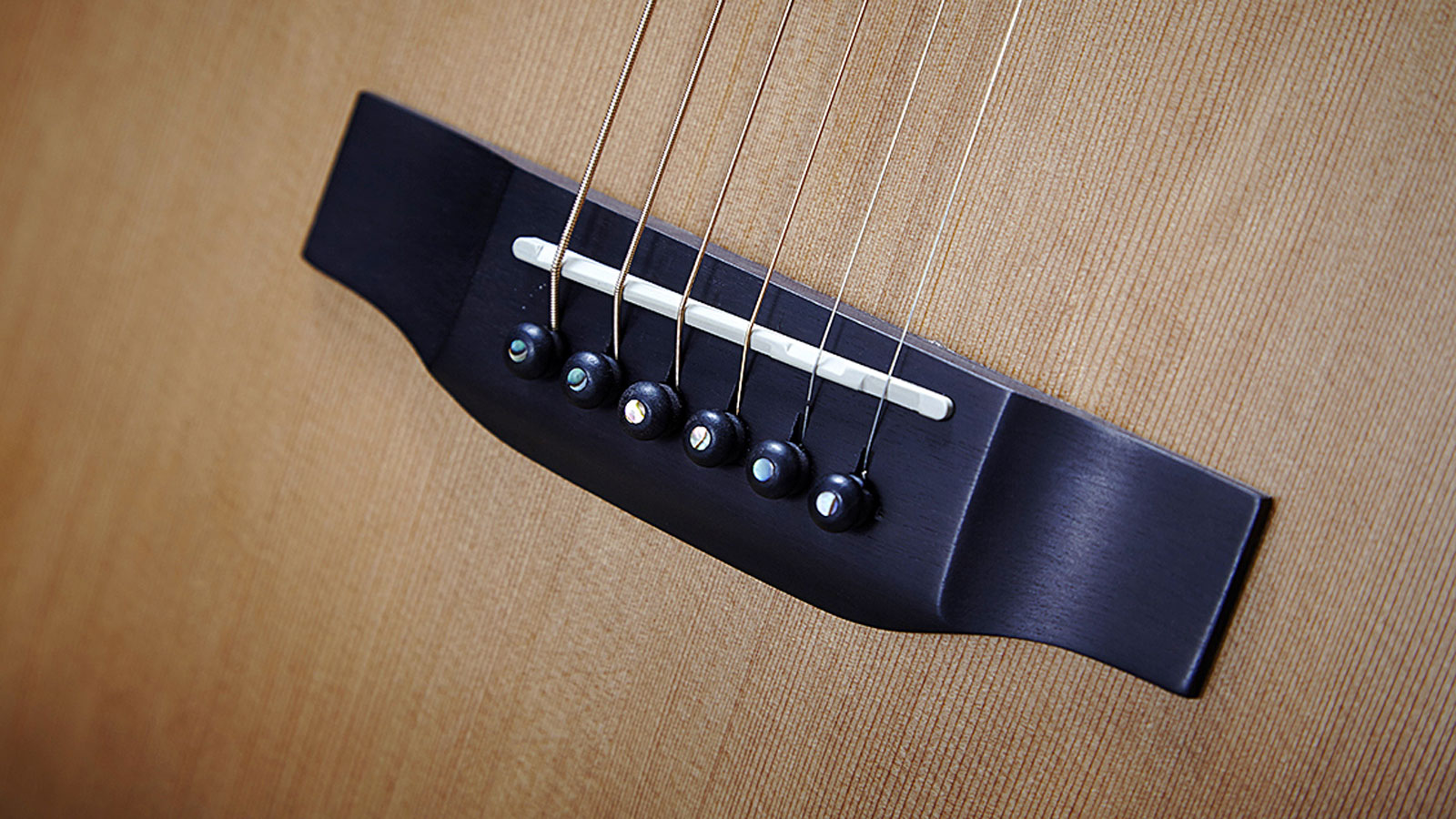MusicRadar Verdict
A credible take on the OM-cutaway, offering softer cedar tones. Pickers may want wider string spacing.
Pros
- +
Bridge options and factory visits are nice touches. Quality construction and materials.
Cons
- -
Not the most original design. Not the best pickup we've heard.
MusicRadar's got your back

Auden Bowman Cedar Cutaway

Top

Head

Bridge
While tweaking a classic design and build in the far east is a superb way to establish instant manufacturing capacity with just a fraction of the associated costs, the results vary wildly. At one end, you find tons of those woeful GSOs - guitar-shaped objects - inevitably destined for some uninterested teen's dusty corner; and at the other are high-quality instruments asking you to consider them seriously alongside the great names of the guitar-making world. You'll have guessed by now that Auden is in the latter camp.
Conceived by boss-man Doug Sparkes and luthier-business partner Rob Bowman, Auden's goal is simply to offer guitars that deliver a combination of spec, playability and tone, at a price unmatched by any other brand. So, no pressure then...
Build
Auden's guitars share many of the same build characteristics. Its current 'one-retail price' means that your buying decision is taken away from which one you can best afford, and points it at which instrument you best like, including this electro-acoustic.
We have a fairly traditional approach to all-solid wood soundbox construction. Clearly very high-quality timbers, exacting attention to detail and superb finishing tell you immediately that both care and craft are high on the Auden agenda.
"In every guitar case is an invitation to visit Auden's Northamptonshire facility, to meet the team and get your guitar set up"
In fact, Sparkes tells us that there are just 15 workers in the Chinese facility, each using hand tools in a 'bench-made' production process. It shows: extremely tidy scalloped X-bracing, struts and lining; beautifully executed maple and rosewood binding front, back and sides.
Against the deep chocolate brown of the solid Indian rosewood, it's very much understated classic-meets-modern precision. Interestingly, Auden does its final assembly - including final neck set, fret finishing, hardware/electronics fitment, buff and polish - here in the UK, along with setups and final QC.
The finish itself is a polyurethane gloss over polyester base, which is likely to remain good looking and protective over many years, albeit never take on the patina of nitrocellulose as time goes on. A nice touch is that in every guitar case is an invitation to visit Auden's Northamptonshire facility, to meet the team and get your guitar set up as you like it.
Want all the hottest music and gear news, reviews, deals, features and more, direct to your inbox? Sign up here.
The solid mahogany neck has a scarfed headstock joint and glued-on heel with a modern, slimmish, rounded profile that will offend nobody. Finished in satin polyurethane, it feels fast to play, the modern vibe continued with a gentle taper in thickness as you go up the neck.
What you can't see is that the neck uses a proper carved and tapered, hide-glue dovetail joint. Traditionalists tend to believe it is better for tone, but it is problematic to do in any great numbers; mortise-and-tenon neck joints are more common where production volume is high.
Auden also supplies a custom-shaped bone saddle in addition to the composite saddle that comes factory fitted. The recommendation is you use bone saddle if your playing is predominantly acoustic (it sounds 'better' acoustically) and the composite if you're regularly plugging-in.
Speaking of which, the supplied pickup is a Schertler Lydia system; an undersaddle transducer, tiny preamp section with two 3V lithium batteries and a mini volume control tucked neatly in the soundhole.
Sounds
The fretting and setup of this guitar is exceptional from a sales point of view; a great compromise of low action and easy playability without sacrificing too much vibration and tone. Coupled with the easy-feeling neck, it's very easy to get to grips with quickly.
If there's a trade-off, it's that a little more fight in the setup and tension in the strings will almost certainly suit more experienced players, and return a stronger tone, too - something the build and materials are more than capable of delivering.
If you want a traditional 000/OM experience, the Bowman delivers with a midrange prominence for a traditional, smaller-guitar type tone. That said, the 'long' 650mm scale length keeps things relatively sparkly with good note separation.
"If you find spruce-topped guitars a little 'hard'-sounding and uninspiring, give something like this Bowman a go"
The cedar seems to have a wide dynamic range when played or picked softly; if you find spruce-topped guitars a little 'hard'-sounding and uninspiring, give something like this Bowman a go and get some cedar in your life. Open-tuned, European-flavoured folkie stuff is well served, for example.
Plugged in, we had a Fishman F1 Analog (in a Martin DCPA4), a K&K Pure Mini under-bridge transducer (Collings CJ35) and Taylor's pre-2014 ES (714ce) on hand for comparison.
The Schertler is consistently the most crystalline and 'under-saddle'-sounding system of the four through our reference AER Compact 60 III. It's not a plugged-in sound we'd describe as 'natural' or 'warm', though it will cut well in a live band environment, to pull out an upside.
Auden will be more than aware that tempting guitarists away from established brands - with their decades of experience, name-artist association, retail presence and large marketing budgets - is a Herculean task.
Judged on the merits of the instruments, however, this guitar delivers a spec/sound/price ratio that's unique in the market, thanks in part to the smart way the production is handled, and the focus on simple, high-quality design.
It represents impressive value when you compare what the big American brands are offering at this price. Auden's auspicious beginning? It mustn't be anything less.